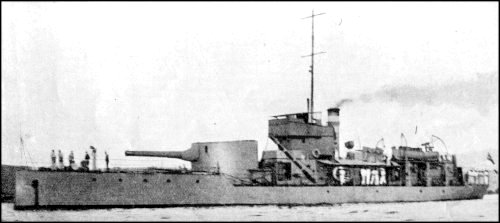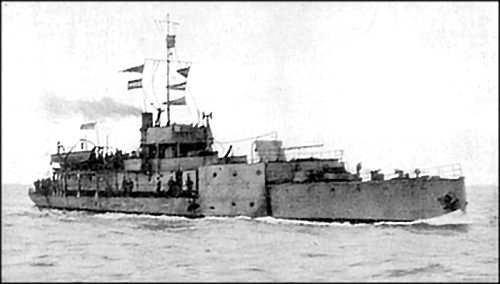
NAVYPEDIA
 Support the project with paypal
Support the project with paypal
Photo

M16 1915
Ships
| Name | No | Yard No | Builder | Laid down | Launched | Comp | Fate |
|---|---|---|---|---|---|---|---|
| M15 | 865 | Gray, Tees | 3/1915 | 28.4.1915 | 6.1915 | sunk 11.11.1917 | |
| M16 | 866 | Gray, Tees | 3/1915 | 3.5.1915 | 6.1915 | sold 1.1920 | |
| M17 | 871 | Gray, Tees | 3.1915 | 12.5.1915 | 7.1915 | sold 5.1920 | |
| M18 | 872 | Gray, Tees | 3.1915 | 15.5.1915 | 7.1915 | sold 1.1920 | |
| M19 | 597 | Raylton Dixon, Tees | 3.1915 | 4.5.1915 | 6.1915 | sold 5.1920 | |
| M20 | 598 | Raylton Dixon, Tees | 3.1915 | 11.5.1915 | 7.1915 | sold 1.1920 | |
| M21 | 599 | Raylton Dixon, Tees | 3.1915 | 27.5.1915 | 7.1915 | sunk 20.10.1918 | |
| M22, 12.1925- Medea | 600 | Raylton Dixon, Tees | 3.1915 | 10.6.1915 | 8.1915 | minelayer 1919, TS 1.1937, sold for BU 12.1938 | |
| M23 | 601 | Raylton Dixon, Tees | 3.1915 | 17.6.1915 | 7.1915 | RNVR drillship Claverhouse 12.1922, BU 4.1959 | |
| M24 | 602 | Raylton Dixon, Tees | 3.1915 | 9.8.1915 | 10.1915 | sold 1.1920 | |
| M25 | 603 | Raylton Dixon, Tees | 3.1915 | 24.7.1915 | 9.1915 | scuttled 16.9.1919 | |
| M26 | 604 | Raylton Dixon, Tees | 3.1915 | 24.8.1915 | 10.1915 | sold 1.1920 | |
| M27 | 605 | Raylton Dixon, Tees | 3.1915 | 8.9.1915 | 11.1915 | scuttled 16.9.1919 | |
| M28 | 606 | Raylton Dixon, Tees | 3.1915 | 28.6.1915 | 8.1915 | sunk 20.1.1918 |
Technical data
| Displacement normal, t | 540 |
|---|---|
| Displacement full, t | 650 |
| Length, m | 54.0 |
| Breadth, m | 9.40 |
| Draught, m | 2.00 - 2.10 |
| No of shafts | M15 - 17, 21, 22: 2 M18 - 20, 23 - 28: 4 |
| Machinery | M15 - 17, 21, 22: 2 VTE, 2 boilers M18 - 20, 23, 25, 28: 4 4-cyl. Bolinder semi-diesels M24: 4 4-cyl. Campbell paraffin engines M26, 27: 4 2-cyl. Bolinder semi-diesels |
| Power, h. p. | M15 - 17: 800 M18 - 20, 23 - 25, 28: 640 M21: 600 M22: 650 M26: 480 M27: 560 |
| Max speed, kts | M15 - 17: 11 M18 - 28: 9 |
| Fuel, t | 45 oil |
| Endurance, nm(kts) | 1440(8) |
| Armour, mm | turret: 152 |
| Armament | M15 - 18: 1 x 1 - 234/47 BL Mk X, 1 x 1 - 76/50 12pdr 18cwt QF Mk I, 1 x 1 - 57/40 6pdr Hotchkiss Mk I (AA) M19 - 23, 25, 28: 1 x 1 - 234/32 BL Mk VI, 1 x 1 - 76/50 12pdr 18cwt QF Mk I, 1 x 1 - 57/40 6pdr Hotchkiss Mk I (AA) M24: 1 x 1 - 190/50 BL Mk IV, 1 x 1 - 76/50 12pdr 18cwt QF Mk I, 1 x 1 - 57/40 6pdr Hotchkiss Mk I (AA) M26, 27: 1 x 1 - 152/40 QF Mk II, 1 x 1 - 76/50 12pdr 18cwt QF Mk I, 1 x 1 - 57/40 6pdr Hotchkiss Mk I (AA) |
| Complement | 69 |
Graphics
Project history
The program of monitor construction had virtually exhausted the stock of heavy gun mountings by early 1915 but Lord Fisher wanted further heavily armed vessels for the amphibious operations planned. There were a number of 234mm guns in stock, mainly Mk.VI type in Edgar class cruisers, as well as a few Mk.X mountings held as spares for Drake and Cressy classes. The four Edgar class being prepared for Dardanelles service were given a uniform armament of 152mm guns, thus releasing 8 guns, and as Gibraliar was to become a depot ship a further 2 guns became available. There were also 4 spare Mk.X guns and Mk.V mountings for Drake class, but only two ships left, Drake and Leviathan, had the Mk.V mounting, so four more monitors could be armed with 234mm guns. There was a considerable difference between the two mountings. The Mk.VI gun was a low-velocity short weapon on an old Vavasseur hand-worked mounting, capable or ranging to only 10km. The Mk.X, in contrast was a high-velocity gun with a range of 14km and capable of four times the rate of fire. The Elswick Ordnance Co was able to modify both mountings to permit elevation to 30°, increasing the range of the Mk.VI to 14.8km and 20km for the Mk.X (22.7km with 4crh shells). The requirements of the design were basic: draught aboul 1.8m, speed 12kts and the simplest construction. Fisher was still anxious to get diesel engines into service, and he pressed for the use of the same Bolinder 'semi-diesel' as had been recommended for the large programme of 'X-lighter' landing barges. Only six of the 4-cylinder 'M' type were available and so two were given four of the 2-cylinder type. One ship received four paraffin engines by the Campbell Gas Co and the rest received conventional steam engines. The guns were allocated as follows: 2 from Edgar into M19 and M26; 2 from Theseus into M21 and M27; 2 from Grafton into M23 and M28; 2 from Endymion into M24 and M25; 2 from Gibraltar into M20 and M22. One spare Mk.X gun and its mounting was held at Malta, and a second had been sent out there before the Gallipoli landings, so M15 and M16 were sent out to be armed there; the other mountings were held at Portsmouth and were sent by road to Hartlepool. In service their worst feature was their lively motion, which seriously impaired their ability to carry out accurate bombardments. As there was a serious shortage of heavy artillery on the Western Front, Admiral Bacon, commanding the Dover Patrol, ordered the 234mm guns to be taken out from M25 (the only monitor then in service in September 1915) and the three (M24, 26 and 27) still fitting out at Middlesborough. Early in 1916 all four were sent to Portsmouth to receive lighter guns .The 190mm guns were spares for Triumph, but when her sister Swiftsure began Atlantic patrols one of her spare guns was allocated to M26. The two 152mm guns had been removed from Redoutable.
Protection
Only the turret was armoured.
Modernizations
M15 and M16 received their 234mm guns at Malta in 7.1915
early 1916, M25: - 1 x 1 - 234/32; + 1 x 1 - 190/50 BL Mk IV
later M26: - 1 x 1 - 152/40; + 1 x 1 - 190/50 BL Mk III
later M27: - 1 x 1 - 152/40; + 1 x 1 - 152/45 BL Mk VII
1916 - 1918, M16: - 1 x 1 - 76/50, 1 x 1 - 57/40; + 1 x 1 - 76/45 20cwt QF Mk I
1916 - 1918, M18, M19, M20, M22: - 1 x 1 - 76/50; + 1 x 1 - 76/45 20cwt QF Mk I
1916 - 1918, M21, M25: - 1 x 1 - 57/40; + 1 x 1 - 76/45 20cwt QF Mk I
1916 - 1918, M23, M24, M26, M27: - 1 x 1 - 57/40; + 1 x 1 - 76/45 20cwt QF Mk I, 2 x 1 - 40/39 2pdr QF Mk II
1917, M21, M23: - 1 x 1 - 234/32; + 1 x 1 - 190/50 BL Mk III
1919, M23: - 2 x 1 - 40/39; + 2 x 1 - 47/50 3pdr Vickers Mk I
1919, M24, M26: - 1 x 1 - 76/50; + 1 x 1 - 76/45 20cwt QF Mk I
1919, M25: + 2 x 1 - 47/50 3pdr Vickers Mk I
1919, M27: - 1 x 1 - 152/45, 1 x 1 - 76/50; + 1 x 3 - 102/45 BL Mk IX, 1 x 1 - 76/45 20cwt QF Mk I
1919-1920, M22: unarmed, can carry 44 mines
Naval service
M15 was torpedoed by submarine UC38 off Gaza 11.11.1917. M21 struck two mines off Ostend 20.10.1918, was towed back to Diver and sank about a mile from West Pier that day. M25 and M27 were blown up and scuttled 16.9.1919 by own crews in Dvina River in Northern Russia because evacuation was unavailable. M28 was 20.1.1918 sunk by gunfire of German cruisers Goeben and Breslau at Imbros (Aegean).
M19 was badly damaged by gun explosion 4.12.1915. M22 was converted to minelayer in 1919-1920, sold for BU in 1938 and wrecked off Cornwall Coast 2.1.1939.
Many thanks to Wolfgang Stöhr for additional information on this page.
 HOME
HOME FIGHTING SHIPS OF THE WORLD
FIGHTING SHIPS OF THE WORLD UNITED KINGDOM
UNITED KINGDOM M15 monitors (14, 1915)
M15 monitors (14, 1915)

